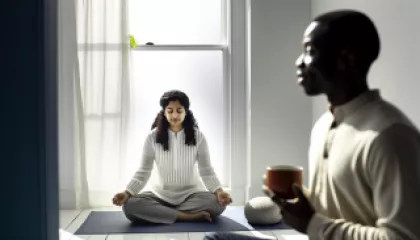Mindfulness vs. Meditation: A Step-by-Step Guide to Understanding the Differences
Welcome to an in-depth exploration of mindfulness and meditation. Mindfulness and meditation, though often used interchangeably, are distinct practices with unique benefits and methods. This article will serve as a step-by-step guide to understanding the differences between mindfulness and meditation, helping you understand these practices more deeply.
Step 1: Understanding Mindfulness
Mindfulness is a mental state achieved by focusing one's awareness on the present moment, while calmly acknowledging and accepting one's feelings, thoughts, and bodily sensations. It's about wholeheartedly experiencing the present moment without judgment or distraction.
- Mindful Living: Mindfulness isn't something that can only be practiced during a specific time or in a specific place. It can be incorporated into your daily life — while eating, walking, cleaning, or during any other daily activity.
- Acceptance: Mindfulness is about observing your feelings and thoughts without judging them. There's no right or wrong way to think or feel in a given moment.
- Non-striving: Mindfulness involves being aware of life as it is, without trying to change anything or reach a particular goal.
Practicing Mindfulness
One simple way to practice mindfulness is through mindful breathing. Here’s how:
- Find a quiet and comfortable place. Sit in a chair or on the floor with your head, neck, and back straight but not stiff.
- Try to put aside all thoughts of the past and the future and stay in the present.
- Become aware of your breath, focusing on the sensation of air moving in and out of your body as you breathe. Feel your belly rise and fall, the air enter your nostrils and leave your mouth. Pay attention to the way each breath changes and is different.
- Watch every thought come and go, whether it be a worry, fear, anxiety or hope. When thoughts come up in your mind, don't ignore or suppress them but simply note them, remain calm and use your breathing as an anchor.
If you find yourself getting carried away in your thoughts, observe where your mind went off to, without judging, and simply return to your breathing. Remember not to be hard on yourself if this happens.
Step 2: Understanding Meditation
Meditation is a practice where an individual uses a technique – such as mindfulness, or focusing their mind on a particular object, thought, or activity – to train attention and awareness, and achieve a mentally clear and emotionally calm and stable state.
- Concentration: Meditation often requires a focus point. This might be your breath, a mantra, or a candle flame.
- Silencing the Mind: While mindfulness accepts the presence of thoughts without judgment, meditation often strives to quiet the mind.
- Structured Practice: Unlike mindfulness, which can be practiced at any moment, meditation is usually a structured practice with a specific time and place.
Practicing Meditation
Here's a simple way to start meditating:
- Choose a tranquil environment. Meditation should be practiced in a peaceful location. A tranquil environment will enable you to focus exclusively on the task at hand and avoid external stimuli and distractions.
- Sit comfortably. Find a position that allows you to be comfortable for the duration of your meditation session. Sit with your back straight, either on a chair or on the floor.
- Close your eyes. Meditation can be performed with your eyes open or closed, however beginners usually find it easier to focus with their eyes closed.
- Focus your mind on the chosen object of attention. As you focus your mind on the breath, mantra, or an image, your mind will begin to relax.
- Don’t engage with your thoughts. As thoughts arise, don’t engage or suppress them. Simply acknowledge them and return your focus to the chosen object of attention.
Step 3: Understanding the Differences
While mindfulness is a form of meditation, not all meditation is mindfulness. Here are some key differences:
- Mindset: Mindfulness is about accepting the present moment without judgement, while meditation often aims to achieve a clear mind.
- Practice: Mindfulness can be practiced at any time, anywhere, while doing anything. Meditation is generally a structured practice, done at a specific time and place.
- Focus: Mindfulness involves being aware of and accepting all thoughts and sensations, while meditation often involves focusing on a single point.
Step 4: Choosing What’s Right for You
Both mindfulness and meditation offer a plethora of benefits, such as reduced stress, improved focus, better emotional health, and more. It's not about which is better than the other, but rather about understanding what each practice offers and deciding what suits your needs and lifestyle best.
You may want to try both practices and see how each one makes you feel. In fact, mindfulness and meditation can complement each other well. You might find that starting with a few minutes of mindfulness helps to prepare your mind for meditation.
Step 5: Regular Practice
Whether you choose mindfulness, meditation, or both, regular practice is key. Just as physical exercise needs to be performed regularly to keep the body fit, mindfulness and meditation require regular practice to reap their benefits.
Remember, it's not about achieving perfection or some ideal state of mind. It's about steady progress and making a commitment to your own mental wellbeing.
Conclusion
Understanding the differences between mindfulness and meditation can help you make an informed decision about what practices would best serve your needs. Both bring unique benefits and can significantly enhance your quality of life.
In the end, whether you choose mindfulness, meditation, or a combination of both, the most important thing is to remain patient with yourself, stay consistent, and enjoy the journey of self-discovery and inner peace.








